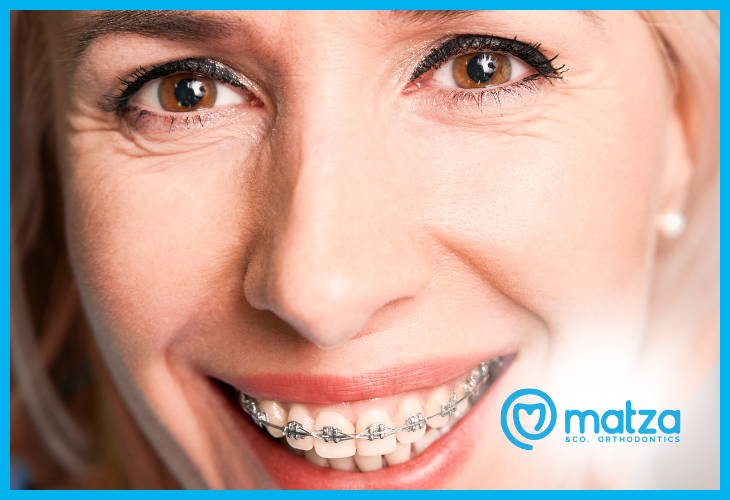Braces on Older Adults

Many people assume that dental braces are only for children and teenagers. Not true! Adults of all ages are electing to get braces later in life both to improve their looks and fix long-standing dental issues. Questions? We are here — and Dr. Matza and his team are experts in the field.
Adults of all ages are electing to get braces later in life both to improve their looks and fix long-standing dental issues — and the trend shows no sign of slowing down.
It’s never too late they say. In December, at the age of 64, I had braces placed on my teeth for the first time.
I’d like to think I’m unique, but I’m not.
Braces are becoming more common for adults, and it’s not just folks in their 20s and 30s. People over age of 50 are also making visits to the orthodontist’s office.
Up-to-date statistics are difficult to come by, but the American Association of Orthodontists reported that 1 million adults had seen an orthodontist in the United States and Canada in 2012.
That was a 40 percent increase from 1989.
In 2014, the association reported that number had climbed to 1.4 million.
Three orthodontists interviewed by Healthline confirm the trend.
Ana Castilla, DDS, an orthodontist in Salem, Oregon, said that five years ago 15 percent of her patients were adults. Today, they make up 40 percent of her clientele.
Most of her adult patients are in their 20s and 30s, but she has a number over the age of 50, including a 78-year-old woman.
“The trend is definitely there,” Dr. Castilla said, who’s a diplomate of the American Board of Orthodontics and an affiliate assistant professor at the Oregon Health and Science University Department of Orthodontics.
Stephen J. Moravec, DDS, MS, the owner of Moravec Orthodontics in Plainfield, Illinois, has seen a similar shift.
His adult patients have risen from approximately 10 percent three decades ago to more than 30 percent today.
“There’s been a huge increase,” Dr. Moravec said, the author of the book “Going the Extra Smile: Merging Technology and Expertise For a Lifetime of Smiles.”
Most of his adult patients are in their 40s, but he sees plenty of post-50 patients, including two people in their 80s.
Henry W. Fields Jr., DDS, MS, MSD, a professor at The Ohio State University College of Dentistry, has noticed similar trends.
He said about 25 percent of most dental practices’ clients are now adults. The percentage can be higher for offices that specialize in adult services.
“I think the increase is there,” Dr. Fields said, who’s also chief of orthodontics at Nationwide Children Hospital’s Department of Dentistry.
Why adults get braces
My case was a bit unusual.
Early last year, I had a bridge and a damaged tooth taken out. That left a gaping hole in the back right side of my mouth.
I wasn’t a good candidate for implants, so it was either get braces or eventually get dentures, something I remember my great-grandfather wearing when I was a child.
I went for the braces.
I have them on my bottom teeth only and they’ll be there for a year and a half.
Their job is to spread out my lower teeth so a single bridge will fit in that wide gap in the back of my mouth.
Castilla said some of her older clients opt for braces for cosmetic reasons. They simply don’t like the way their teeth look. This includes her 78-year-old patient.
Moravec said about half of his older patients ask for braces for cosmetic reasons. That includes his two 80-something clients.
“People just want to look better,” he told Healthline.
The other half of his clients need something fixed.
They’ve either lost a tooth or they’ve had previous dental work that’s causing problems. Or their teeth are simply showing the wear and tear of five or more decades of work.
The same is true in Castilla’s office.
Many of her older clients need to have their bite adjusted because it’s been altered from years of chewing or past dental work.
“You’d be surprised how quickly teeth can wear down,” Castilla said.
Fields pointed to a 2015 survey by the American Dental Association for the impact bad teeth can have.
In the online questioning conducted by the Harris Poll, about 25 percent of the 15,000 adults who responded said they avoid smiling because of their teeth’s appearance.
In addition, 29 percent of low-income adults and 28 percent of young adults said they felt the appearance of their mouth and teeth affected their ability to interview for a job.
“People are thinking more about aesthetics,” Fields told Healthline.
He added that more older adults are in a position to get braces.
In the past, the teeth and gums of older adults were simply in too poor of shape for braces.
Today, adult teeth are in better shape due to superior dental care and prevention measures such as fluoridated water.
“You can’t put braces on teeth that aren’t there,” Fields said.
Brushing away the stigma

Some of today’s adult orthodontist clients had braces as children. Others didn’t.
Castilla said past experience doesn’t seem to matter because braces on older adults is becoming more common.
“The stigma of orthodontist treatment for adults is gone,” she told Healthline.
She and Moravec said there are a number of reasons for this.
First, technology is better. Braces are easier to install and easier to manage. They also aren’t as obvious as in previous generations, especially with the use of clear braces.
Castilla also noted that in many instances the treatment period is now shorter than it used to be.
She adds social media is making the trend more acceptable. Adults now post photos of themselves with their new braces, encouraging others to do the same.
There are hundreds of photos with the #adultbraces on Instagram.
Obstacles for adults
But there are factors that make braces for adults a little more difficult to maneuver.
The first is gum disease.
A substantial percentage of adult orthodontic patients have gum disease. Castilla estimated about half of her clients over the age of 30 have gum disease. About 70 percent of her patients over the age of 65 do.
She said this sometimes leads to a delay in braces while a dentist treats the disease.
Another obstacle is bone loss.
Older adults don’t have the same thickness of bone they did as children.
This can present problems because teeth move through bone and anchor themselves to bone after braces are installed.
Castilla said teeth in thinner bones are like fence posts in shallow holes. They don’t hold up as well.
Moravec notes that medications taken by women for osteoporosis can get in the way of tooth movement.
Then there’s past dental work.
Most children have had minimal work done on their teeth. Not the same with adults.
Crowns, fillings, and other previous work can present problems.
In addition, teeth tend to migrate more slowly as you get older.
“In children, you put on the braces and the teeth move easily,” Castilla said.
Moravec agrees that dealing with adult braces can be more difficult.
“Most children have healthy mouths,” he said. “With adults, it’s a little different.”
Paying the price
My orthodontist said at the outset that my insurance wouldn’t cover my braces.
She said insurance plans rarely cover orthodontic work once a person reaches the age of 20.
She was right. I paid $4,000 up front for the braces on my bottom teeth. It can cost $5,000 to $6,000 for more extensive or complicated work.
Castilla said insurance companies see adult braces as more of a luxury than a necessity.
She paid for them herself when she got braces at the age of 23.
And she doesn’t see any shift occurring soon.
“Insurance isn’t changing,” she said. “It’s one of my pet peeves.”
Moravec agrees.
“If anything, it’s probably going in the other direction,” he said.
Dr. David Guarrera, DDS, vice president and chief dental officer for Met Life, said there are insurance plans that cover adult orthodontics work. It’s a matter of whether companies and employees want to pay for them.
“Each employer who purchases a dental plan makes the decisions related to their particular dental insurance benefit design and what the coverage elements are, including orthodontic treatment,” Guarrera told Heathline. “Employers make those decisions on what is to be covered or not covered based upon multiple factors. For example, they evaluate the cost of the plan to both the employer and to their employees, the value and employee desire for all of the dental services that may or may not be covered, and whether the services covered prevent and treat dental disease.”
Guarrera added that most companies that do offer adult orthodontics coverage are larger firms with at least 5,000 benefit-eligible employees.
Fields agrees that the situation comes down to money.
“For insurance companies, it’s a matter of controlling costs,” he said. “They see [adult braces] as aesthetics rather than a functional benefit.”
Fields said at this point most adult braces are probably discretionary instead of necessary.
He said if people want insurance plans to provide coverage for adult braces, they should be ready to pay higher premiums.
“It’s a matter of what kind of policies they want to buy,” Fields said.
Braces, in addition to transforming your smile and making it more beautiful, give you more health and quality of life. Discover the many advantages of getting braces, no matter your age. Schedule your appointment today at (561) 368-3480 and join our Facebook community.
Reference: [https://www.healthline.com/health-news/getting-braces-at-age-64]
